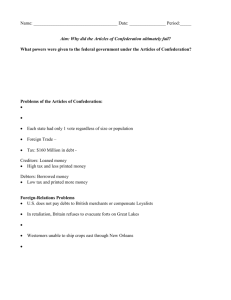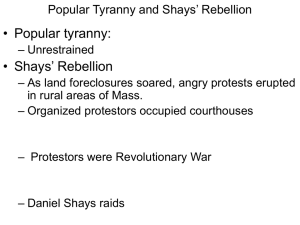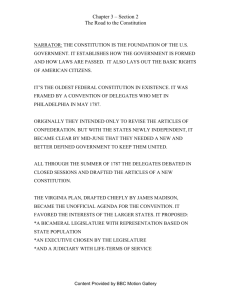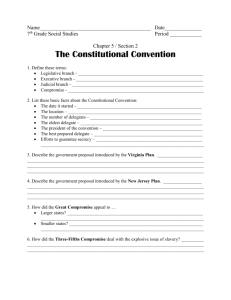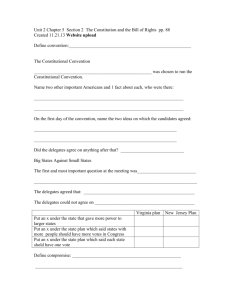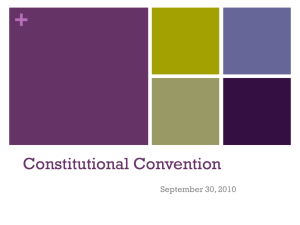Constitutional Convention
advertisement
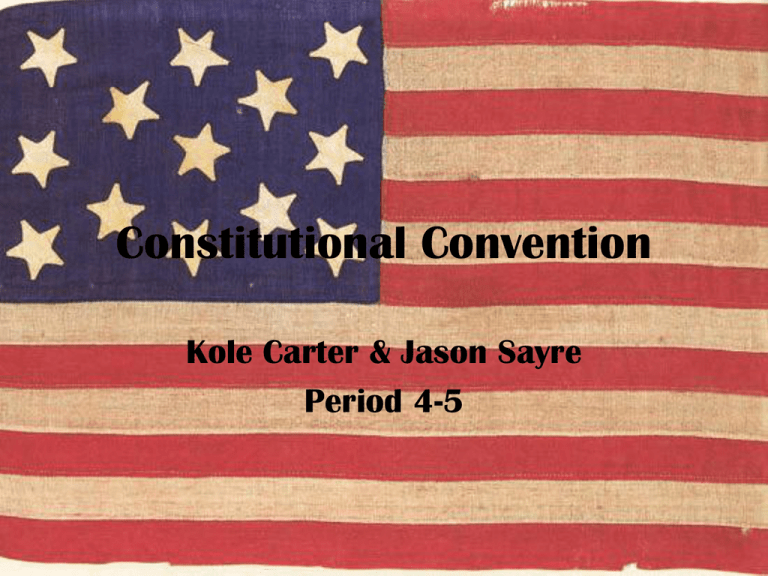
Constitutional Convention Kole Carter & Jason Sayre Period 4-5 Why Did the Delegates Meet? • In 1786, Americans noticed that the Articles of Confederation needed to be amended. The Problems of the Articles • The Articles allowed almost no power to the Congress. The Congress had no power to tax and no power to demand its request to the states for money or soldiers. • Only one house of the Congress in command. • No President, or executive branch. • Each state got one vote no matter its size. • No central form of government. • Must have majority vote of 2/3 to pass any law. • No judicial system, every state had its own laws. Attendees of the Convention Oliver Ellsworth Abraham Baldwin John F. Mercer William S. Johnson William Few Elbridge Gerry Roger Sherman William Houstoun Nathaniel Gorham Richard Bassett William L. Pierce Rufus King Gunning Bedford Jr. Daniel Carroll Caleb Strong Jacob Broom Daniel Jenifer Nicholas Gilman John Dickinson Luther Martin John Langdon George Read James McHenry David Brearly Attendees of the Convention Jonathon Dayton William R. Davie William C. Houston Thomas Mifflin John Blair Alexander Martin Gouverneur Morris James Madison William Livingston Richard D. Spaight Robert Morris George Mason William Paterson Hugh Williamson James Wilson James McClurg Pierce Butler Edmund J. Charles Pinckney Randolph Charles Cotesworth George Washington George Wythe Alexander Hamilton John Lansing Jr. George Clymer Thomas Fitzsimons Robert Yates Benjamin Franklin Pinckney William Blount Jared Ingersoll John Rutledge Dates of the Convention • After the struggle continued, The Continental Congress, in February 1787, called for a convention of delegates to meet in May in Philadelphia. • On May 25, 1787, a week later than scheduled, delegates from the various states met in the Pennsylvania State House in Philadelphia. The “Virginia Plan” was drafted. • On June 14, 1787, a competing plan, called the "New Jersey Plan," was presented by delegate William Paterson of New Jersey. • By September, 1787, final compromises were made and it came time to vote. The First Meeting • The May convention’s first order of business was electing George Washington president of the Convention and establishing the rules. • James Madison chiefly drafted the “Virginia Plan.” • The Virginia Plan called for a strong national government with both branches of the legislative branch apportioned by population. • The plan gave the national government the power to legislate "in all cases in which the separate States are incompetent" and even gave a proposed national Council of Revision a veto power over state legislatures. The “New Jersey Plan” • The "New Jersey Plan," was presented by delegate William Paterson of New Jersey. • The New Jersey Plan kept federal powers rather limited and created no new Congress. 3/5 Compromise • At the insistence of delegates from southern states, Congress was denied the power to limit the slave trade for a minimum of twenty years and slaves--although denied the vote and not recognized as citizens by those states--were allowed to be counted as 3/5 persons for the purpose of apportioning representatives and determining electoral votes. • Delegates compromised on the controversial issue of apportioning members of Congress. Connecticut Compromise • Delegate, Roger Sherman, put forward this plan. • Representation in the House of Representatives would be based on population while each state would be guaranteed an equal two senators in the new Senate. The Final Vote • Each state had only one vote regardless of delegate numbers. • Thirty-nine of fifty-five delegates supported adoption of the new Constitution. • Rhode Island sent no delegates because they opposed the convention. • A signing ceremony was held on September 17, 1787.


